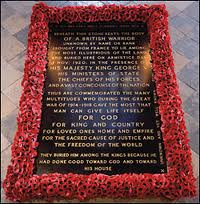
(For those who may have missed it, here is my 2009 Remembrance Sunday post.)
A few words about Remembrance Day and the tomb of the Unknown Warrior in Westminster Abbey from Woolly Days:
The event commemorates the time of day the war ended. At 11 am on 11 November 1918 the guns of the Western Front finally fell silent after more than four years of brutal trench warfare … The poetic timing of the event, the eleventh hour of the eleventh day of the eleventh month, helped to cement it in grateful public affections. Up to 13 million people died in the conflict that destroyed the empires of Germany, Austria, Russia and Turkey.
In May 1919, an Australian journalist, Edward George Honey, wrote a letter to the London Evening News in which he proposed a respectful silence to remember those who had given their lives in the war. The letter caught the attention of King George V and on 7 November he issued a proclamation which called for a two minute silence. On the first anniversary of the armistice four days later, the two minutes’ silence was instituted as part of the main commemorative ceremony at the new Cenotaph in London. In Britain, the second Sunday of November is now known as Remembrance Sunday. At 11am on this day, a two minute silence is observed at war memorials, cenotaphs, religious services and shopping centres throughout the country.
At the west end of the Nave of Westminster Abbey is the grave of the Unknown Warrior, whose body was brought from France to be buried here on 11 November 1920. The grave, which contains soil from France, is covered by a slab of black Belgian marble from a quarry near Namur. On it is the … inscription, composed by Herbert Ryle, Dean of Westminster …
Around the main inscription are four texts:
(top) THE LORD KNOWETH THEM THAT ARE HIS,
(sides) GREATER LOVE HATH NO MAN THAN THIS and UNKNOWN AND YET WELL KNOWN, DYING AND BEHOLD WE LIVE,
(base) IN CHRIST SHALL ALL BE MADE ALIVE.
The idea of such a burial seems first to have come to a chaplain at the Front, the Reverend David Railton (1884-1955), when he noticed in 1916 in a back garden at Armentières, a grave with a rough cross on which were pencilled the words “An Unknown British Soldier”. In August 1920 he wrote to the Dean of Westminster, Herbert Ryle, through whose energies this memorial was carried into effect. The body was chosen from unknown British servicemen exhumed from four battle areas, the Aisne, the Somme, Arras and Ypres. (The number of bodies exhumed varies in different accounts between four and six). The remains were brought to the chapel at St. Pol on the night of 7 November 1920. The General Officer in charge of troops in France and Flanders, Brigadier General L.J.Wyatt, with Colonel Gell, went into the chapel alone, where the bodies on stretchers were covered by Union Flags. They had no idea from which area the bodies had come. General Wyatt selected one and the two officers placed it in a plain coffin and sealed it. The other bodies were reburied.
We will remember.
***
GJ - We cannot say enough about the sacrifices of our military and their families.
***
GJ - We cannot say enough about the sacrifices of our military and their families.
